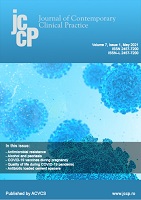Plasmid-mediated quinolone resistance genes in clinical isolates from a tertiary healthcare institution in South-West Nigeria
Plasmid-mediated quinolone resistance genes in clinical isolates from a tertiary healthcare institution in South-West Nigeria
Author(s): Abiodun Ojewuyi, Babatunde Odetoyin, Oladipo AboderinSubject(s): Regional Geography, Health and medicine and law
Published by: Asociația pentru Creșterea Vizibilității Cercetării Științifice (ACVCS)
Keywords: plasmids; quinolone resistance; PMQR; clinical infections;
Summary/Abstract: Plasmid-mediated quinolone resistance (PMQR) is a growing concern worldwide. Reports from Nigeria suggest quinolone-resistant clinical isolates are common, however, reports on the prevalence of PMQR genes are few. This study aimed to determine the prevalence of PMQR genes in quinolone-resistant isolates from a tertiary healthcare hospital in Nigeria. This was a cross-sectional study involving 390 gram-negative bacilli from diverse clinical infections. The isolates were characterized by the Microbact TM identification kit and susceptibility patterns determined by the Kirby-Bauer disc diffusion technique. All quinolone-resistant isolates were investigated for the carriage of PMQR genes by multiplex polymerase chain reaction (PCR). Data analysis was performed with appropriate descriptive and inferential statistics. The isolates were distributed as Escherichia coli (n=121; 31.0%), Klebsiella species (n= 112; 28.7%), Pseudomonas aeruginosa (n=59; 15.1%), Proteus species (n=43; 11.0%), Salmonella species (n=6; 1.3%) and others. They were commonly resistant to nalidixic acid (62.6%), co-amoxiclav (57.7%), norfloxacin (52.3%), ofloxacin (52.1%) and ciprofloxacin (51.0%), but were least resistant to imipenem (n=36; 9.2%). Of 244 quinolone-resistant isolates, 180 (73.8%) harboured one or more PMQR gene with high prevalence of efflux-mediating determinants (qepA, 22.5%; oqxAB, 21.1%), and aminoglycoside acetyltransferase (aac(6’)-Ib-cr, 19.7%). A proportionately low level of target-protecting determinants: qnrB, 13.2%; qnrS, 8.7%; qnrA, 5.9%; qnrD, 4.5% and qnrC, 4.2% was found. There is widespread quinolone resistance and distribution of PMQR genes in clinical isolates in Nigeria with a preponderance of efflux-mediating determinants and aminoglycoside acetyltransferase. This emphasizes the need for antimicrobial stewardship to guide the appropriate use of antibiotics and prevent the spread of resistance genes.
Journal: Journal of Contemporary Clinical Practice
- Issue Year: 7/2021
- Issue No: 2
- Page Range: 56-64
- Page Count: 9
- Language: English

